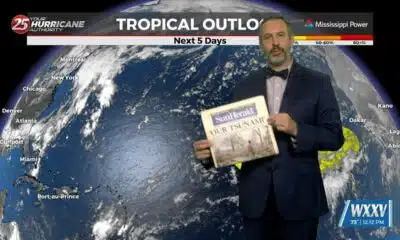News from the South - North Carolina News Feed
North Fork Reservoir’s toppled fusegate — part of key safety system on dam —still not replaced • Asheville Watchdog
Ten months after Tropical Storm Helene wrought devastation on our area, a key safety feature of the North Fork Reservoir’s dam has not been replaced and likely won’t be until next year — after the end of the 2025 hurricane season.
During Helene, a concrete fusegate at North Fork — the city’s main reservoir that provides about 80 percent of the system’s drinking water — tipped over and tumbled down the concrete auxiliary spillway, as designed. The fallen gate released an enormous amount of water from North Fork, which had collected enough to activate the concrete enclosure that acts as a sort of safety valve for dangerously rising water levels.
Essentially a standing concrete box that’s 16 feet high, the fusegate was one of eight on the auxiliary spillway, a system the city completed in 2019 at a cost of $38.6 million. The total span of the spillway is 218 feet, and each bay holding two gates is 50 feet wide.
The gate that tumbled was designed to start to tip at the level of a 200-year flood and flip over during a 1,000-year event.
Weather experts have described Helene in our area as a “1,000-year rainfall event.”

Clay Chandler, spokesperson for the Asheville Water Resources Department, which operates North Fork, said the reservoir’s watershed recorded 17.51 inches of rain between Sept. 25 and Sept. 27. The fusegate that tipped went over between 9:30 a.m. and 10 a.m. Sept. 27.
“The gate has not been rebuilt,” Chandler said via email in early July. “We are working through the city’s professional services contracting process. Once a vendor is selected, that contract will require Council approval before moving forward. We’re hopeful construction begins early next year. The bucket will be rebuilt on site.”
Chandler said the gate missing during the current hurricane season (June through November) — typically the time of year when western North Carolina sees flooding events from tropical storms or their remnants — does not pose any vulnerability for North Fork.
“The reservoir will not fill to full pool with the missing gate,” Chandler said, referring to the normal height of water in the dam. “It can get to about 7.5 feet below full. There is no additional vulnerability to the system from hurricanes if the gate is present or missing.”
Mark Landis, an engineer with Schnabel Engineering, which designed the auxiliary spillway at North Fork and its fusegate system, also said the missing gate “does not pose a dam safety hazard.
“It just means that the water level in the reservoir will be controlled by the elevation of the base of the lost fusegate rather than the principal spillway,” Landis said.
In other words, the base level of the missing fusegate now controls the water level of the reservoir, not the primary spillway.
Chandler said the “system is operating the same way it always has, just with a slightly lower reservoir level until the fusegate can be rebuilt.
“As for the timeline, we’d obviously like for it to move as quickly as possible,” Chandler said. “However, we are legally required to follow North Carolina local government procurement law and, as a result, are moving through the bid process to replace the fusegate.”
Chandler said the department did not have any cost estimates for the replacement yet, is in cost-sharing discussions with FEMA, and expects to receive federal funding for the replacement.
“The future of concrete and steel pricing is very uncertain, which is why we’re moving through a competitive bid process to ensure we maximize cost savings,” Chandler said. “The project will require significant concrete pours and crane operations, so it will not be cheap.”

Kat Russell, a spokesperson for the Division of Energy, Mineral and Land Resources, which oversees the North Carolina Dam Safety Program, said July 11 that the state did receive reports that the fusegate engaged during Helene.
“Such engagement actually allows for more drainage and allows for more flow out of the emergency spillway and therefore does not negatively impact the safety of the dam,” Russell said via email. “The fusegates are located on the auxiliary spillway, which is located at a higher elevation than normal pool (the usual height of water in the dam). Therefore, the normal pool would not likely be affected.”
Russell also pointed out that the reservoir typically is drawn down before expected large storms, which also allows for significant storage. It was down 8 feet before Helene hit.
“As of our latest inspection, the fusegate is still out, which as previously mentioned will only allow more water to drain in the event of a storm and relieve potential pressure on the dam,” Russell said. “We anticipate that the City of Asheville will be submitting a repair plan through their engineer of record but we currently do not have an ETA on that.”
A dam safety inspection dated Oct. 24, 2024, noted that one fusegate broke free, and that “Erosion was observed at the bottom of the concrete chute. Erosion excavated soil behind both wing walls.”

What happened with the fusegate?
Under pressure from relentlessly rising water in North Fork, the fusegate literally toppled over, broke apart and washed partway down the auxiliary spillway. And that’s exactly what it was supposed to do.
Previously, the dam had a system of three “tainter gates,” curved gates operated by chain pulley systems that would release water during heavy rain events. They had to be operated by staff, and the ones in place in North Fork were old. Landis, the Schnabel Engineering employee, said during a previous high-water event one chain actually broke when staff tried to open it.
The idea with the fusegate system is that it’s automatic and takes human effort — and potential for error — out of the equation. Landis explained how a fusegate works.
During flooding, water goes into the inlet well at the base of the concrete fusegate, entering through piping that runs underneath the platform of the weir, the zig-zag structure that holds all eight gates. Hydroplus, the company that invented the fusegate system, notes that when water fills the inlet well, pressure builds beneath the module, generating destabilization.

“That provides hydraulic uplift,” Landis said. “And so it becomes unstable at that point. Then you have a tipping block at the downstream toe of that gate so that it just doesn’t slide. It actually tips over. That’s what creates the instability — that gate is designed to flip over. And then, because you’ve got so much water already in that spillway system, it basically just floats down the chute, and then it breaks up, falls apart at the very bottom.”
The standard used in designing the system was the “Probable Maximum Flood,” Landis said. Sometimes called probably maximum precipitation, the model at North Fork was site-specific and based on a Tennessee Valley Authority regional model, according to the city’s website on the spillway upgrade. In the model, the PMP estimated 28 inches of rainfall in 24 hours.
On a Q&A page about the spillway/fusegate project, the city notes, “The auxiliary spillway would start trickling water over its weirs (fusegates) at the 200-year storm event. The first fusegate breaks out at just over the 1,000-year storm event. In order for all fusegates to let go, a 50,000-year storm event would need to occur.”
Chandler said the idea with the fusegates is to protect the earthen dam of North Fork, originally constructed in 1955, from becoming compromised and failing. Under the design, “water begins cascading over the surfaces of all the fusegates when the lake is 9 feet above full pool.”
That’s a flow rate of 940 cubic feet per second (CFS) that will begin to cascade down the spillway.
“At 10.5 feet above full pool, provided there is enough pressure from the lake, the first fusegate activates, or tips,” Chandler said.
Did the fusegate tipping cause more severe flooding?
Some in the community have suggested the fusegate tipping over resulted in a surge of water that greatly exacerbated the flooding downstream, particularly in the Swannanoa and Biltmore Village areas. And some survivors reported seeing a surge of water on the morning of Sept. 27.
The Swannanoa River, which runs from east to west from Black Mountain to Asheville, reached historic levels that day. It peaked at 27.33 feet at 3:45 p.m., according to U.S. Geological Survey gauge data. Four days earlier, it was flowing at 1.44 feet.
On its page about fusegate spillways, the Association of State Dam Safety Officials states that such spillways provide a way to pass “more frequent smaller flood events by overtopping the fusegates (via labyrinth or straight weir) and more remote larger flood events by tipping and displacing sections of the fusegate spillway.” The system provides “the ability to increase (maximize) reservoir storage and/or discharge capacity.”

But the association also offers a warning:
“An important consideration is the potentially large discharge capacity associated with operation from a small increase in reservoir water surface (particularly during remote large flood events that result in tipping and displacing sections of the fusegate spillway). The amount of flow that could be released from an operating fusegate must be carefully evaluated in terms of downstream impacts.”
Asked more specific questions about whether fusegate dams pose specific safety risks downstream, or if such a release could cause catastrophic surges downstream, a spokesperson for the association said, “Unfortunately, these questions are outside of our scope.”
Chandler and Landis say the tipping of one fusegate would not have added a significant surge of water downstream, particularly not as far as Swannanoa or Biltmore Village, which are about 7 and 17 miles west, respectively. Directly below the spillway and in the vicinity of North Fork, which is in Black Mountain, the effect certainly would have been noticeable, Landis said, and the city’s main water transmission line and a backup line below the dam did wash out, leaving the city without water for weeks.
But farther downstream, any surge would’ve been much more dissipated. Landis said they would have to run a “very detailed model” on the water release to measure specifically where surge waters went.
“I don’t know what the incremental effect is downstream several miles with one fusegate release, but it is not feet — it is inches,” Landis said.
Landis said once water gets spread out over a large area and into a floodplain, “that surge you’re talking about is not really that much realized.” At the site — the spillway — it will look like a lot of water is going out, but Landis pointed out that the entire watershed was feeding the flood, not just North Fork.
The surge by the spillway would be intense.
“But as you go downstream and everything is spreading out, you’re not going to really see that incremental change that much,” Landis said, referring to Swannanoa or Biltmore Village. “I don’t even know if it would be an inch of difference from that far down.”
The North Fork Reservoir and its roughly 20,000-acre watershed make up 17 percent of the land that comprises the entire Swannanoa River Valley watershed, according to a City of Asheville media presentation in 2020 on emergency preparedness and the North Fork dam project. It noted that the reservoir itself contributes 21 percent of the water in the watershed.
During Helene, a lot of water was coming in from the Swannanoa watershed’s deep slopes, which reach 4,000 feet on one side and 6,000 on the other. The Swannanoa Valley has a huge drainage area, about 60 square miles in all.
“There was a lot of water coming in from the rest of the watershed,” Landis said. “Maybe if you were immediately right below the dam, you might see something, but once it gets out and spreads out, then I’m not sure you could actually notice a difference.”
Philip Prince, a professional geologist and adjunct professor at Virginia Tech University, previously told Asheville Watchdog that the Swannanoa Valley is about 4.5 miles long and “not much over one mile wide in the area that flooded badly.”
Following “activation” of the fusegate, Chandler said “up to 1,766 cubic feet per second of water begins to flow down the spillway.”
“This volume is not additional to the 940 cubic feet per second that began to cascade over the spillway” during flooding “but represents the total flow at that level,” Chandler said. So 1,766 cubic feet per second “was the total flow on the auxiliary spillway for the Hurricane Helene event.”
If the rainfall had worsened, the second fusegate is designed to tip at t 11.5 feet above full pool. Additional fusegates could continue activating in half-foot increments until the spillway reaches 61,809 CFS in a theoretical event with all 8 gates tipped out.
“Having this system in place prevented an earthen dam from failing, which would have released 802,139,037 cubic feet — about 6 billion gallons — of water in minutes,” Chandler said.
Helene brought the highest river crests on record, surpassing the great flood of 1916. The Swannanoa River at Biltmore crested at 26.1 feet, more than five feet higher than 1916 and slightly above the apparent 26-foot crest in April 1791, “making this effectively the worst flood along the river since North Carolina became a state,” the State Climate Office wrote.
Jeff Wilcox, a hydrogeologist and UNC Asheville professor of environmental science, has studied the river flow rates during Helene. He reached the same conclusion the city and its engineer did about the fusegate tipping and any potential it had to add to damaging flood levels.
Wilcox said the total flow rate the city gave for the tipped fusegate – 1,766 cubic feet per second – “would represent a very small portion of the estimated 57,600 CFS peak discharge in Biltmore Village,” as recorded by the U.S. Geological Survey.
Philip Ellis, a hydraulic engineer in Hendersonville, said any definitive analysis and modeling of the fusegate effect would require serious budget and time. Generally, Ellis said, his “intuition aligns” with Landis’s take that the fusegate tipping would’ve caused the water to rise by inches not feet.
The amount of water passing through the tipped gate “would be a small portion of this flood,” Ellis said.
Asheville Watchdog welcomes thoughtful reader comments about this story, which has been republished on our Facebook page. Please submit your comments there.
Asheville Watchdog is a nonprofit news team producing stories that matter to Asheville and Buncombe County. John Boyle has been covering Asheville and surrounding communities since the 20th century. You can reach him at (828) 337-0941, or via email at jboyle@avlwatchdog.org. The Watchdog’s local reporting is made possible by donations from the community. To show your support for this vital public service go to avlwatchdog.org/support-our-publication/.
Related
The post North Fork Reservoir’s toppled fusegate — part of key safety system on dam —still not replaced • Asheville Watchdog appeared first on avlwatchdog.org
Note: The following A.I. based commentary is not part of the original article, reproduced above, but is offered in the hopes that it will promote greater media literacy and critical thinking, by making any potential bias more visible to the reader –Staff Editor.
Political Bias Rating: Centrist
This article provides a detailed, factual report on the technical aspects and public concerns surrounding the damaged fusegate at North Fork Reservoir following Tropical Storm Helene. It includes explanations from engineers, government officials, and experts without editorializing or inserting ideological perspectives. The tone is neutral, and the focus is on infrastructure, safety, and engineering processes rather than political critique or advocacy. Although it touches on public interest and government response, it does so without assigning blame or promoting a policy agenda, adhering to a balanced journalistic standard.
News from the South - North Carolina News Feed
Judges in two federal cases cite due process to block Trump immigration moves
SUMMARY: Over Labor Day weekend, two federal judges in Washington, D.C., blocked aggressive Trump administration immigration actions. Judge Sparkle Sooknanan halted deportation flights carrying 10 unaccompanied Guatemalan children, citing due process concerns. These children, aged 10 to 17, had pending immigration cases and feared returning home. Earlier, Judge Jia Cobb struck down a policy expanding expedited removal nationwide, which fast-tracks deportations without judicial review, ruling it likely violated constitutional rights. The Trump administration aimed to deport up to 600 Guatemalan minors under a pilot program. Both judges, appointed by President Biden, emphasized protecting immigrants’ due process rights amid the administration’s crackdown.
Read the full article
The post Judges in two federal cases cite due process to block Trump immigration moves appeared first on ncnewsline.com
News from the South - North Carolina News Feed
Buy Now, Pay Later starting to affect credit in new ways
SUMMARY: Buy Now, Pay Later (BNPL) services, allowing purchases paid over four installments often without interest, are increasingly impacting credit scores and traditional lending. About 23% of Americans used BNPL last year, but many are unaware of its credit effects. Previously, BNPL repayments weren’t reported to credit bureaus, so timely payments didn’t boost credit, while missed payments could harm credit if sent to collections. Recently, major BNPL lenders began reporting to Experian and TransUnion, and FICO will include BNPL data in new credit score models starting this fall. However, credit score improvements may be modest, and some lenders remain cautious about BNPL users.
Source
News from the South - North Carolina News Feed
How school bus drivers and police use AI to stop vehicle violations
SUMMARY: As the school year begins, Bus Patrol uses AI-powered cameras on over 40,000 school buses across 22 states to catch drivers illegally passing stopped buses, endangering children. In Pennsylvania’s Lower Merion School District, all 135 buses are equipped with these cameras, which activate when the stop arm extends. Drivers frequently ignore the stop sign, with violations occurring multiple times daily. Recorded violations are reviewed by police, leading to fines up to $300 for first offenses. Since installation, nearby districts have issued thousands of tickets. The system enhances enforcement, aiming to protect children by encouraging drivers to stop safely at school buses.
Transportation Correspondent Gio Benitez is in a school district outside Philadelphia that’s using the technology to help crack …
-
Mississippi Today4 days ago
DEI, campus culture wars spark early battle between likely GOP rivals for governor in Mississippi
-
News from the South - Louisiana News Feed7 days ago
K+20: Katrina alters local health care landscape, though underlying ills still the same
-
News from the South - North Carolina News Feed6 days ago
Parasocial party: Why people are excited for the Taylor Swift, Travis Kelce engagement
-
Local News6 days ago
Police say Minneapolis church shooter was filled with hatred and admired mass killers
-
Local News Video5 days ago
08/29 Ryan's “Wet End to the Week” Friday Forecast
-
News from the South - Arkansas News Feed6 days ago
Sylvan Hills defeats Maumelle in Zero Week thriller
-
News from the South - Kentucky News Feed6 days ago
Lexington Man Convicted of Firearms Offenses
-
The Conversation7 days ago
Pregnant women face tough choices about medication use due to lack of safety data − here’s why medical research cuts will make it worse











































